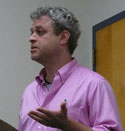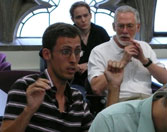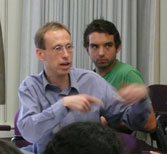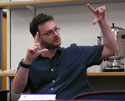

![]()
::: postdoc fellowships
::: senior fellowships
::: resident fellowships
::: associateships
![]()
being here
::: visiting
::: the last donut
::: photo album
::: center home >> being here >> last donut? >> curiel |
12 September 2008 For me, one of the great pleasure of philosophical analysis comes when we find a way to see that something doesn't just happen to be that way; it has to be that way. That I am expecting to be the upshot of today's talk. Our speaker is Erik Curiel, who is a Visiting Fellow in the Center this year. Erik's PhD is from the University Chicago, where, among other notables, he worked with two much admired figures, the philosopher David Malament and the mathematical physicist, Bob Geroch. They both think and analyze problems in deeply mathematical ways. That mode would also be Erik's today. From previews of his abstract, I knew that it would tax my powers to keep up with him. But I was certainly looking forward to trying. As we took our seats, I noticed that the overhead projector had been skewed on the diagonal and a screen set up. I was too busy trying to locate a seat with a view from which I could photograph to ponder why this odd arrangement was there. I worked through the usual introductory formalities as quickly as I could and turned the floor over to Erik. His topic is a familiar one, classical mechanics. He is promising, however, that we will see it in a new light. The classical mechanics Erik has in mind is rather more general than the one most people learn in high school. There, it is all about masses rolling down inclined planes, forces, accelerations and the Newtonian equation we all learn by heart "F=ma". There are other fancier ways of formulating classical physics. One is the "Lagrangian" formulation. In it, we associate a numerical magnitude, its "Lagrangian," with each possible state of the classical system. We know the system will evolve over time. A mass on a spring will bounce up and down, just so. But which of all possible movements will be "just so"? The remarkable result of Langrangian mechanics is that it will be the motion that makes this Langrangian magnitude the biggest, as we sum along the motion (or, sometimes, smallest, depending on how you define things). Another of the fancier ways is the Hamiltonian formulation. Once again one has a magnitude, the Hamilitonian that is a property of each system at any moment. It is, mostly, just the energy of the system. The specific form of the Hamiltonian dictates once again just how the system evolves over time. In these fancier guises, classical mechanics is much more than merely the analysis of balls rolling down inclined planes. It includes such things as the theory of electric and magnetic fields; and, I suspected, a great deal more. Erik did not delimit the range, however. Why bother with these different formulations? Each has its special virtues. The Lagrangian formulation carries over easily from non- relativististic to relativistic physics, where motions are treated geometrically as trajectories of maximum length in spacetime. The Hamiltonian formulation affords the easiest stepping stone to elementary quantum mechanics and the easiest place to analyze thermal systems, such as a gas, consisting of many, many, many, many, many molecules.
That familiar equivalence was Erik's target today. They may be equivalent in the sense of being intertransformable, but they are not equally natural. There's nothing I can say in English that cannot be said in French or Italian. But French in the language of love and Italian the language of poetry. Today, Erik assures us, he will show us that the Lagrangian is the natural language of classical physics. (Need I say that last sentence would sound better in Italian?) There's more. In pressing through his project, Erik has found all sorts of interesting philosophical insights flowing from his analysis and he would finish up by telling us about them. As Erik's introductory sketch of the main argument slowly unfolded, I began to wonder if that would be possible. We were some 20 minutes into what he'd planned as a 40 minute talk and we are still dealing with preliminary sketches. There came a moment when Erik too realized that time was not just a coordinate, but a finite magnitude. He continued his cheery presentation, pacing back and forth, beaming with each result and illustrating them sometimes with wild gestures. But his pacing took on a new urgency as he realized that some significant acceleration would be needed if he was to finish on time or even finish at all. So let me hurry you through his analysis. It drew heavily on a theorem proved by his advisor and hero, Bob Geroch. The state of a classical system is fixed by specifying a few parameters. We know the state of mass on a spring if we know its position, its velocity, the forces pressing on it, and so on. These parameters can be divided into what he called configuration variables and velocity-momentum variables. They are intrinsically different. The former must vary continuously. They are things like the position of a mass or the magnitude of an electric field. The latter can vary discontinuously. They are things like the forces that push the mass or the charges that create the field. A force can be a sudden bump. A charge distribution might be present here and then, after a sharp boundary, not there. The key insight is that these latter parameters present interactions with the environment and the way that they differ from the configuration variables imposes a very specific and very definite structure on the space of states. Erik's carefully chosen, simple words were leather reins encircling snorting horses of mathematics, champing at their bits. As Erik drew us deeper into his story, these horses grew testier and Erik's hands grew more tired and started to loosen. What started as a simple trot had now advanced to a gallop. I tried to keep an eye down the road to where the horses were taking me, but their speed was rapidly outpacing my cognitive powers. I now found why Erik has arranged for the screen to be set over to one side. He wanted to be able to wander to the blackboard that now lay exposed and scratch symbols and pictures in chalk. We soon had images of state spaces and families of curves drawn on them, tracing out the evolution in time of some anonymous classical system. As our speed increased, I called out to Erik concerning a simple equation he written on the blackboard. I needed to slow the horses, even if only for a moment. "Is this v exactly the same as that v? Yes? Then how are you getting interactions if the v's don't change?" Erik paused and drew a little diagram in the universal language of the little arrows of vectors. "Oh, I get it," I thought and probably said aloud. And then the horses where off again. Erik's time was running short. The fiber bundles and tangent spaces and quotient spaces and affine spaces kept coming as he drove towards his final conclusion. When real poets are born, they are born speaking Italian, naturally. That these interactions happens in the quite specific way described is all it takes to give you the state space of the Lagrangian formulation at birth, naturally. It does not give the Hamiltonian formulation. That can be had eventually by transforming the spaces, but that transformation will obscure the natural expression of the difference between configuration variables and interaction variables. Dante can be translated in all literal thoroughness, but it will always be a pale copy. It was now five minutes past one o'clock, long after I'd have expected a speaker to stop. I had warned Erik that people might leave around one since they have to teach classes. But no one had left. They were all sitting, perhaps a little more stiffly than an hour ago, and listening. Erik took the opportunity to lay out some philosophical morals. One I found striking. Structural realists worry that changes in scientific theories threaten the idea that the central terms of those theories are about what is really out there in the world. So they tell us that we can let things change a bit. Maybe Maxwell thought light was a vibration in the aether; and Einstein tells us it is undulating matter in its own right. Some things have changed. Both have waves and wavelengths and the same set of field equations. Those stable structure, persisting through change, are what is really there. But now look at these two formulations of classical physics, Erik continues, they differ so much in their structures that there is very little left in common. What does that leave for structural realists to build their claims on? We broke for more donuts, bagels and coffee and hastily resumed with question time. I found the discussion especially helpful. Jeremy Butterfield, Gordon Belot, Al Janis, Claus Beisbart and Balazs Gyenis (and me--interjecting myself into the queue) all helped Erik pull on the mathematical reins. Claus' question about symmetries in the variables of the Hamiltonian theory rang the bell. A sudden look of enlightenment flashed over Erik's face in the closing moments. He remembered that he'd found a very simple way of seeing how it all worked just five minutes before the talk. "In the Hamiltonian formulation you can switch the p's and the q's. In the Langrangian, you cannot--it knows too much about the dynamics." Ninety minutes ago, that wouldn't have meant much to me. But now, momentarily, it seemed so clear and just the time to wind things up. I went to the closet, emerged and said "I present you with this umbrella."
John D. Norton Erik Curiel |













